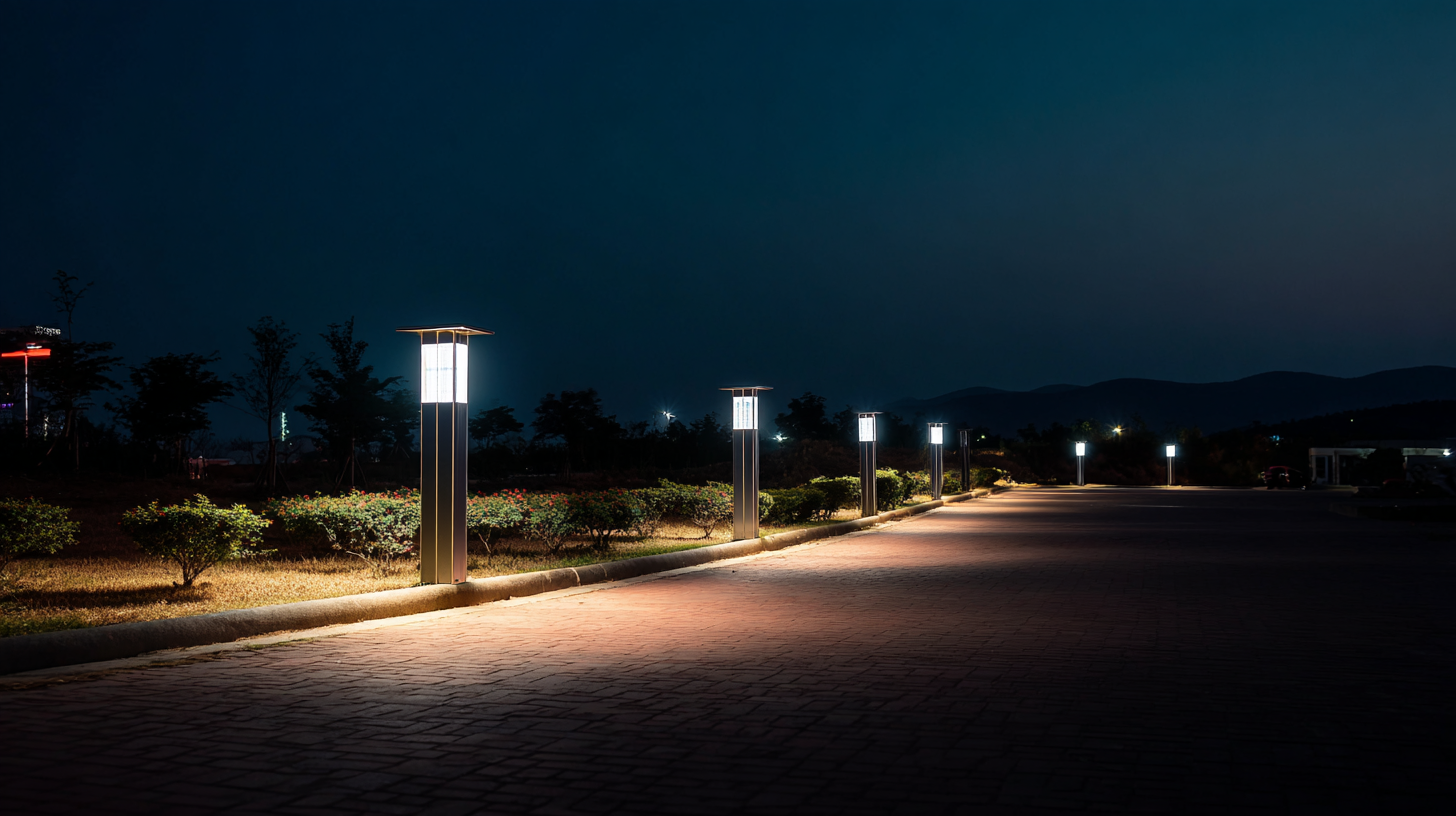Unlocking Performance with the Best Solar Post Lights Technical Specifications You Need to Know
 In an era where sustainability and
energy efficiency are paramount,
Solar Post Lights have emerged as a
viable solution for outdoor lighting needs. According to a report by the
International Energy Agency, the demand for
solar energy technologies is expected to grow significantly, potentially
doubling by 2025. Solar Post Lights not only
reduce electricity costs but also minimize the carbon footprint associated with traditional
lighting solutions. Furthermore, advancements in photovoltaic technology have enabled these
fixtures to operate effectively even in low-light conditions, providing reliable
illumination for gardens, pathways, and commercial spaces. By understanding the
essential technical specifications, such as lumens output,
battery longevity, and
weather resistance, consumers can make
informed decisions that maximize performance and energy savings. This blog will explore the best
practices for integrating Solar Post Lights into various environments while highlighting their
benefits and specifications.
In an era where sustainability and
energy efficiency are paramount,
Solar Post Lights have emerged as a
viable solution for outdoor lighting needs. According to a report by the
International Energy Agency, the demand for
solar energy technologies is expected to grow significantly, potentially
doubling by 2025. Solar Post Lights not only
reduce electricity costs but also minimize the carbon footprint associated with traditional
lighting solutions. Furthermore, advancements in photovoltaic technology have enabled these
fixtures to operate effectively even in low-light conditions, providing reliable
illumination for gardens, pathways, and commercial spaces. By understanding the
essential technical specifications, such as lumens output,
battery longevity, and
weather resistance, consumers can make
informed decisions that maximize performance and energy savings. This blog will explore the best
practices for integrating Solar Post Lights into various environments while highlighting their
benefits and specifications.
Understanding Essential Import and Export Certifications for Solar Post Lights
When it comes to solar post lights, understanding the significance of essential import and export certifications is crucial for ensuring compliance and maximizing market potential. Certifications such as Underwriters Laboratories (UL) and International Electrotechnical Commission (IEC) standards play a vital role in guaranteeing that products meet safety and performance requirements. According to a recent industry report, products that comply with these certifications have seen a corresponding increase in consumer trust, leading to a 15% rise in sales for compliant manufacturers.
In addition to safety certifications, awareness of trade regulations is key for companies involved in the import and export of solar lighting products. The ongoing discussions surrounding Section 232 investigations highlight the increasingly rigorous scrutiny of materials entering the market. Businesses must stay informed about tariffs and import restrictions, as even minor changes can significantly impact costs and operational decisions. For instance, compliance with the new tariffs could raise the costs of imported components by an estimated 10%, underlining the importance of navigating these regulations effectively to maintain competitive pricing and ensure product availability.
Key Technical Specifications That Impact Solar Post Light Performance
When choosing solar post lights, understanding the key technical specifications can significantly influence performance and satisfaction. One of the primary factors to consider is the solar panel efficiency. Higher efficiency panels capture more sunlight and convert it into electricity, allowing the lights to operate longer and illuminate brighter throughout the night.
Typically, the best solar post lights feature polycrystalline or monocrystalline panels, with the latter being more efficient but often at a higher cost.
Another crucial specification is the battery capacity. The capacity, measured in milliampere-hours (mAh), determines how much energy can be stored for use during nighttime. A larger capacity battery allows for extended illumination duration and improved reliability during cloudy days. Additionally, look for lights equipped with lithium-ion batteries instead of older nickel-cadmium options, as they tend to offer better performance, longer life, and faster charging times.
Finally, the lumen output is vital for assessing the brightness of the solar post lights. Higher lumen ratings indicate a brighter light, which is essential for visibility and security. Typically, lights with a lumen output between 100 and 500 are considered effective for pathways and landscaping. By focusing on these key specifications, you can ensure that your solar post lights will meet your needs while enhancing your outdoor space.
Comparative Analysis: Traditional vs. Solar Post Lights in Energy Efficiency
As the demand for sustainable energy solutions grows, a comparative analysis of traditional and solar post lights reveals significant advances in energy efficiency, particularly with the capability of solar technology to substantially decrease operational costs. According to industry reports, traditional post lights typically operate at an efficiency rate of around 80 lumens per watt, while newer solar post lights can achieve up to 120 lumens per watt, showcasing a clear advantage in brightness output per energy unit consumed.
Further emphasizing the shift towards solar technology, recent insights into solar post light pricing trends indicate a substantial decline in manufacturing costs—down by approximately 30% over the past five years. This decline is attributed to advancements in photovoltaic cell technology and energy storage solutions, making solar lighting systems not only more efficient but also more accessible. The typical solar street lighting system, which consists of solar panels, control systems, and batteries, continues to evolve, positioning it as a viable alternative to traditional incandescent or fluorescent systems in urban planning.
In summary, as energy efficiency drives innovation in street lighting solutions, the sector is moving toward a future where solar post lights not only illuminate streets sustainably but also significantly reduce overall maintenance and electricity costs for municipalities.

Market Trends: Growing Demand for Solar Energy Solutions in Outdoor Lighting
The outdoor lighting market is currently witnessing a significant shift towards sustainable solutions, driven by a growing demand for solar energy. According to a recent report by Allied Market Research, the global solar lighting market is projected to reach $13.4 billion by 2027, growing at a CAGR of 21.5% from 2020 to 2027. This surge can be attributed to increased awareness of renewable energy benefits and reduction in operational costs associated with traditional lighting methods.

Moreover, a report from MarketsandMarkets highlights that the residential segment represents a major share of this growth, fueled by consumer preferences for eco-friendly solutions. In fact, nearly 60% of homeowners are considering solar products for outdoor lighting due to their energy efficiency and lower carbon footprint. The transition to solar post lights not only supports the environment but also enhances outdoor aesthetics and safety, all while reducing electricity bills. As technology improves, the efficiency and design of solar lights continue to evolve, making them an increasingly attractive option for consumers and businesses alike.
Navigating Industry Standards and Best Practices for Solar Lighting Products
When navigating the world of solar post lights, understanding industry standards and best practices is crucial for ensuring optimal performance and longevity. The specifications of these lighting products can significantly influence their efficacy, making it essential to consider elements such as lumens output, battery capacity, and solar panel efficiency. For instance, a higher lumen output means brighter light, which is pivotal in outdoor settings where visibility is key. Equally important is selecting units with high-quality batteries that provide longer operational hours and maintain performance even on cloudy days.
In addition to technical specifications, adherence to industry certifications can greatly enhance the reliability of solar lighting products. Look for certifications like UL, CE, or FCC, which indicate that the products have undergone stringent testing and compliance with safety and performance standards. Manufacturers who prioritize quality and sustainability will often highlight their adherence to best practices in design, materials, and energy efficiency. By being well-informed about these standards, consumers can make enlightened choices, leading not only to superior lighting solutions but also to more sustainable living practices.
